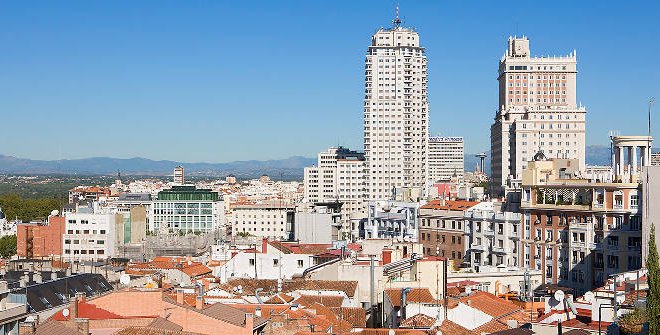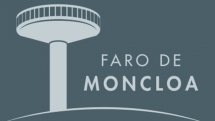Princesa
From Plaza de España to Moncloa, countless tourist attractions await you, including an authentic Egyptian temple!
 templo_de_debod_2023.jpg
templo_de_debod_2023.jpg COMPRASPrincesaZara_1404894326.018.jpg
COMPRASPrincesaZara_1404894326.018.jpg NOCHEPrincesaTNTHeavyBar_1404896158.942.jpg
NOCHEPrincesaTNTHeavyBar_1404896158.942.jpg infoehistoriaPrincesaPlazadeEspana_1404896308.147.jpg
infoehistoriaPrincesaPlazadeEspana_1404896308.147.jpg FarodeMoncloaMuseoAmerica_1429788037.721.jpg
FarodeMoncloaMuseoAmerica_1429788037.721.jpg

- Info and history
- Art and culture
- Parks and gardens
- Leisure and nightlife
- Shopping and more..
Princesa is one of the largest tourist destinations in Madrid, a district with many must-see attractions.
The district’s main street, Calle Princesa, is one of the longest and busiest in Madrid. It runs between Plaza de España and Moncloa, where you’ll see the Triumphal Arch, the Headquarters of the Spanish Air Force and the Faro de Moncloa transmission tower. Plaza de España was part of the Gran Vía development plan of 1911. Two iconic buildings face the square, Torre de Madrid and Edificio España.
Following its refurbishment, the new Plaza de España is one of the new city’s main hubs, with a large green space, sculptures, children's play areas, and cycle paths, as well as a central area for festive, cultural, commercial, and sporting events. The square and its surroundings are home to the Monument to Cervantes, where you can take your picture next to the statues of Don Quijote and his faithful squire Sancho Panza; the fountain known as Fuente de La Concha , which has now been moved in front of the Church of Santa Teresa and San José; and Fuente del Cielo, a marble fountain inspired by the Madrid sky. When the work was being carried out, workers uncovered the remains of the surrounding wall of the former San Gil Barracks, which will now be housed in the Temple of Debod.
In sharp contrast to the adjacent Calle Princesa, always noisy and crowded, Calle de Ferraz or Paseo del Pintor Rosales are much quieter. In the area are nineteenth-century buildings that were inhabited by minor aristocrats.
This neighbourhood is home to the Ciudad Universitaria, where most of the faculties and colleges of the Complutense University of Madrid and the Polytechnic University of Madrid are located, as well as over thirty students’ residences and facilities of the National University of Distance Education (UNED) of which its sports facilities stand out (with the Complutense swimming pool which is extremely popular in the summer season-, the Botanical Garden and the Crown of Thorns. This area is also home to the Moncloa Palace, headquarters and official residence of the President of the Spanish Government.
Madrid can boast of being one of the very few cities in Europe that have an authentic monument from ancient Egypt. The temple, built 2,000 years ago in the Ptolemaic era, was dismantled stone by stone and brought to Madrid from Lower Nubia. It was a gift from the Egyptian Government in 1972, as a token of gratitude for the help offered by Spain to save the Nubian temples from being submerged during the construction of the Aswan Dam. This is one of the best places in Madrid to enjoy a postcard sunset.
Housed in the palatial mansion of the seventeenth Marquis of Cerralbo, the museum shows visitors how an aristocratic family lived at the turn of the nineteenth century. It contains a fabulous collection of weapons, precious decorative objects and paintings by Tintoretto, Frans Snyders and El Greco.
Shrine of San Antonio de la Florida
Built in 1792, the present-day shrine is the third of a group of churches dedicated to the popular saint from Lisbon. The exterior sobriety contrasts with the magnificent frescoes inside, painted by Goya in 1798. The imposing chapel of San Antonio de la Florida contains some magnificent frescoes painted by Goya in 1798 and is also the great painter’s final resting place. Every year, in June, Madrid celebrates San Antonio de la Florida, with festivities mainly taking place in La Bombilla Park and the San Antonio chapel.
Estación del Norte
The old Estación del Norte is one of the finest examples of iron and glass structures in Madrid. It started operating in 1882 and ceased to serve as a railway station in 1993. It was renovated later to become a shopping centre and public transport hub, including intercity bus and commuter train stations.
This museum revisits the history of fashion from the sixteenth century to the present. Don’t miss the star costumes designed by some of the best known couturiers of the twentieth century. It has a restaurant and a pleasant outdoor terrace.
This is a great place to learn about the arts and customs of the native inhabitants of the American continent from the Pre-Columbian era to the present day.
Santa Teresa de Jesús y San José Church
This church, which stands in the Plaza de España, was declared a Cultural Monument in 1995. The building has a medieval-inspired façade and a 35-metre-high Byzantine-style dome decorated with colourful yellow, orange, red, and blue tiles, topped by a royal crown.
Princesa is bounded by the river Manzanares to the south, where most green areas are to be found.
One of the largest parks in Madrid, Parque del Oeste was developed in the dawn of the twentieth century, commissioned by Madrid Mayor Alberto Aguilera. The northern tip, the oldest part of the park, has beautiful landscaped gardens. The Rosaleda de Ramón Ortiz, with more than 500 species of rose plants from around the world, is well worth a visit.
Gardens of the Temple of Debod
Surrounding the Egyptian temple are gardens from which you can look at the beautiful sky at sunset, when it takes on contrasting blue and red hues. The battle between warm and cold colours to take over the horizon gives a great chance to take the picture of your life.
Located next to the Hermitage of San Antonio de la Florida. It is famous for hosting the open-air cinema in the summer season, an interesting plan to have a good time with the family known as Fescinal.
Not so close to the centre of the city as are the parks we’ve just mentioned, Dehesa de la Villa is exquisitely beautiful. A 15 minutes’ walk from Ciudad Universitaria, it’s more of a forest with landscaped areas than a true park. Cerro de los Locos, the highest part of the park, affords stunning views of Sierra de Guadarrama. This is one of the favourite places for residents of Madrid to go running or cycling.
Madrid from above
The Teleférico (cable car) (temporarily closed for technical inspection) offers unparalleled panoramic views of Madrid’s monumental cityscape and the river Manzanares. The Teleférico travels 2.5 kilometres and climbs 40 metres from Rosales station, in Princesa, to Casa de Campo.
There are many cinemas around Plaza de los Cubos and Calle Martín de los Heros where you can watch films in their original language with subtitles. Watching original versions gives you the chance to hear the real voices of actors and actresses.
With a small outdoor swimming pool, the Terraza de Poniente, located on the hotel’s rooftop, offers amazing panoramic views over the Guadarrama Sierra.
Princesa never sleeps
The area is home to more than one nightlife venues. Close to Ciudad Universitaria and the Metropolitano tube station are pubs and clubs open on weekends and weekdays too. Students gather in them for a drink. A similar atmosphere but with fewer students, with pubs to have a drink and dance to the rhythm of popular hits or listen to live music, can be found in the streets around the Moncloa public transport hub. Electronic music is the star in the clubs close to Plaza de España. The area around the Plaza de España is also home to the Garra Bar at the Hotel Barceló, a place to enjoy a fine cocktail and enjoy DJ sessions. The Ginkgo Sky Bar, located on the 12th Floor of the Hotel VP Plaza de España, has magnificent panoramic views of Madrid.
Very close to the Sabatini Gardens we find Las Tablas, Madrid’s most important tablao flamenco venue. And in the heart of the Plaza de España, the cosy, modern Soho Club Madrid serves interesting dishes that combine market cuisine with traditional stews and locally sourced produce. Inside is the Soho Club Teatro, with a cultural programme that spans all kinds of performing arts.
The emblematic Edificio España houses the RIU Plaza España Hotel, a 26-storey building 117 metres high. The facilities include event rooms, commercial premises, an outdoor swimming pool located on the 20th floor, a 24-hour gymnasium, buffet breakfasts with show cooking stations as well as the Sky Bar and lobby bar.
And next to the Plaza de España is the new Fitz Club Madrid inspired by the writer F. Scott Fitzgerald and the clubs and parties of the roaring 20s. A concept that combines technology and live music.
The Principe Pío train station is home to the Warner Music Station, a new creative hub encompassing Warner Music Spain and Warner Chappell Music Spain designed to meet the creative and technical needs of artists and composers. The building houses a theatre, night club, a Hall of Fame, museum and restaurant for users to enjoy.
The main shopping area is in Calle Princesa, particularly at the junction with Calle Alberto Aguilera where, in addition to the large department stores, such as El Corte Inglés, we can find the leading young fashion chains, such as the Inditex Group, sportswear, such as Decathlon, accessories and travel items, as well as cosmetics, beauty products or gifts.
In the Plaza de España we find the newest branch of the Spanish fashion chain Zara, spread over 7700 m2, with 3815 m2 of shop floor divided over four levels. The store has a fresh look, new product display areas, and the latest technology.
In this shopping district you can also find all kinds of electronic devices, from the latest cameras and mobile phones to tablets and e-readers. Treat yourself to any of the thousands of products available to take back home.
In the middle of a long day, you may want to eat something. In Princesa there are are fast food eateries and cafés to regain strength before resuming your shopping spree. One option is the new ice cream parlour and café in Plaza de España, Töto Ice Cream.
Next to Alberto Aguilera's Salvador Bachiller shop is Bloom, Salvador Bachiller's new gastrobar where you can enjoy a brunch, a romantic dinner or a cocktail in an atmosphere reminiscent of a garden full of flowers.
Furthermore, this extensive area frequented by university students – Don Oso, Massart Pizza or Van Gogh Café – coexists with some of the capital’s varied culinary references, such as Casa Mono, Casa Mingo, El Club Allard, Cokima, Madrí Madre or the Casa de Valencia. The Paseo de la Florida is also an excellent option to savour delicious tapas and portions.
Located very close to the Plaza de España and the Royal Palace and just five minutes from Madrid Río, the Príncipe Pío Commercial Centre is in a building of historic interest, such as the former Norte Train Station, built in the 19th century, which also offers a complete range of fashion and leisure, thanks to its varied catering proposals or its 3D cinemas, which are open every day of the year.
In one of the unused wings of the Príncipe Pío station stands the Gran Teatro CaixaBank Príncipe Pío, a large multi-space theatre with a wide range of entertainment including theatre and concert programmes, as well as restaurants.
-
Map of Tourist Areas (PDF)
Gourmet Markets
-
San Miguel Market
-
San Antón Market
-
Platea Madrid
-
San Ildefonso Market
-
Gourmet Experience Callao
-
Gourmet Experience (Serrano)
-
Nightlife: Princesa
OFFICIAL PRODUCTS
- Contact
- General Conditions
- Legal Terms and Conditions
- Cookies policy
- Privacy settings
- madrid.es















